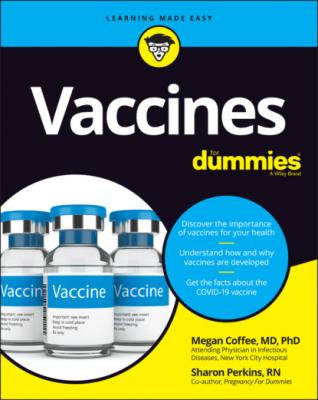Vaccines For Dummies. Sharon Perkins
Читать онлайн.| Название | Vaccines For Dummies |
|---|---|
| Автор произведения | Sharon Perkins |
| Жанр | Здоровье |
| Серия | |
| Издательство | Здоровье |
| Год выпуска | 0 |
| isbn | 9781119787839 |
Trying to keep track of vaccination schedules can be complicated. We make it easier by describing which vaccines are required for infants and children at which ages in Chapter 8. We include the same information for adults in Chapter 9. Chapter 10 explains when you or your child should not get vaccinated, due to certain health conditions. Thankfully, these conditions are rare.
Preparing for Potential Vaccine Side Effects
Any substance you put inside the human body has the potential to cause side effects. In most cases, side effects don’t affect everyone, and most side effects aren’t serious or long lasting. But it’s always nice to be prepared for typical side effects, and it’s important to be aware of more serious side effects that necessitate a visit to your healthcare provider. We spell out side effects and what to watch for in Chapter 7.
Optimizing Your Immune Response
No, there are no magic bullets, pills, or other easy ways to do this. But Chapter 15 includes information that you may not have realized on ways to keep your immune system healthy, from the effects of smoking and alcohol on your immune system to the benefits of getting enough sleep. We also include info on supplements often taken for good health.
Chapter 2
The (Non) Life of a Virus
IN THIS CHAPTER
You’ve probably said, “I caught a virus” dozens of times in your life. And no wonder — so far humans have identified close to 7,000 virus species. We know there are hundreds of thousands more and think there are millions, if not trillions, more. Some viruses infect people; others infect other animals; and still others infect plants, fungi, or even bacteria. (There are even virophages that infect viruses themselves.) Viruses — infective agents that can only reproduce inside another cell — are pretty simple, but what they cause is not so simple. They may cause no symptoms. They may wreak havoc on us. They may cause something in between or go back and forth.
Virus particles (virions) are very small — smaller than we can see with a regular microscope. Yet they still manage to perplex us. Sometimes it even seems like they outwit us. As with any enemy, getting to know what a virus is and how it works is instrumental to thwarting it, and this chapter can help. As you also find out here, some viruses can be prevented by vaccines, while others still evade science’s attempts to prevent them.
Looking Inside Your Average Virus
Successful viruses turn our cells into photocopiers, churning out virions — more and more infectious viral particles. When we get sick, say with the flu, the cells in our bodies may produce as many as 100 trillion virions. That’s more than all the stars in the Milky Way.
With all of these copies, there are bound to be mistakes. Viruses make lots of mistakes. They often don’t copy their genetic material exactly the same each time. These miscopies are called mutations. Not all mutations are bad; many are dead ends. Headlines may say that a virus is mutating, but that’s just what viruses do. Viruses mutate; birds fly. Mutations, especially collecting over time, can lead to different variants or strains, and sometimes these changes can evade our immune responses or change how sick they make us.
